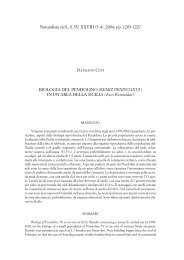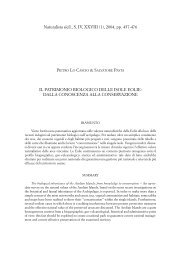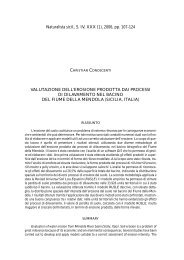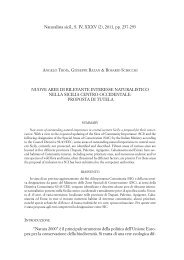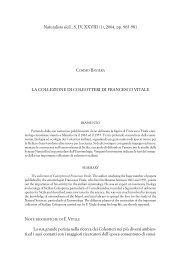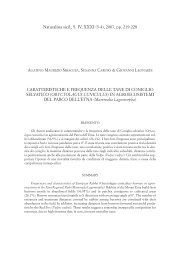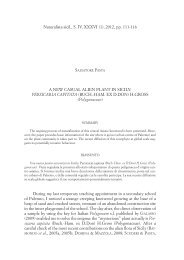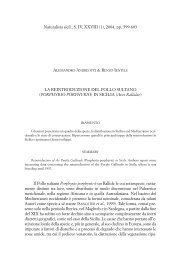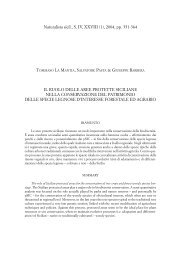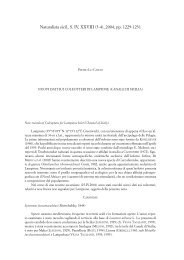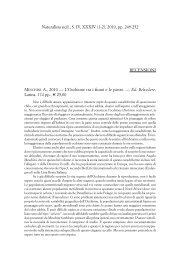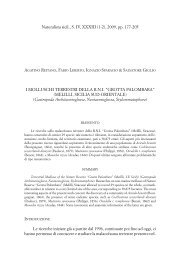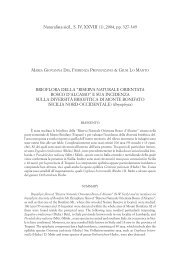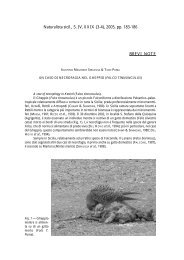2007,pp - Società Siciliana di Scienze Naturali
2007,pp - Società Siciliana di Scienze Naturali
2007,pp - Società Siciliana di Scienze Naturali
You also want an ePaper? Increase the reach of your titles
YUMPU automatically turns print PDFs into web optimized ePapers that Google loves.
Gall midges (Diptera Cecidomyiidae) of Sicily<br />
289<br />
species in Sicily without giving a locality. Distribution: European, with large<br />
area. DARVAS et al. (2000) evaluate this species as a minor pest of plum trees.<br />
Resseliella oleisuga (Targioni-Tozzetti, 1886)<br />
Diplosis oleisuga Targioni-Tozzetti, 1886<br />
Clino<strong>di</strong>plosis oleisuga (Targioni-Tozzetti, 1886)<br />
Thomasiniana oleisuga (Targioni-Tozzetti, 1886)<br />
Larvae develop under the bark of twigs of Olea europaea L. (Oleaceae).<br />
They may cause withering of the twigs (BARNES, 1948). Two generations develop<br />
per year, one during the spring and summer and the other in the autumn.<br />
TARGIONI-TOZZETTI (1886) described this species, without giving any locality<br />
where larvae were coming from, presumably in southern Italy and Sicily.<br />
Occurrence: LIOTTA (1981) mentioned this species as a pest of table olives in<br />
Sicily. Distribution: Me<strong>di</strong>terranean, known to occur in Italy, Croatia, Greece,<br />
Syria, Israel and Morocco; it was also found in Turkey (SKUHRAVÁ et al., 2005).<br />
Stefaniella atriplicis Kieffer, 1898<br />
Larvae cause small swellings on stems of Atriplex halimus L. (Chenopo<strong>di</strong>aceae),<br />
only about 4-5 mm in <strong>di</strong>ameter. Larvae pupate in galls. KIEFFER<br />
(1898) described this species, basing on material sent him by M. Olivier from<br />
Algeria. Occurrence: DE STEFANI (1906c) found galls at Palermo. Distribution:<br />
Me<strong>di</strong>terranean.<br />
Stefaniella trinacriae De Stefani, 1900<br />
Larvae cause fusiform plurilocular swellings on stems of Atriplex halimus<br />
L. (Chenopo<strong>di</strong>aceae) of a size of a nut (Pl. III, Fig. 14). Larvae pupate in the<br />
galls. Two generations per year. DE STEFANI (1900) <strong>di</strong>scovered this species in<br />
Sicily and decribed adults and larvae without mentioning the exact locality,<br />
which presumably was on the western coast of the island. He reared from galls<br />
several species of parasitoids (DE STEFANI, 1900, 1905a). DE STEFANI jr (1942)<br />
reported it also from Caltanissetta in March. Occurrence: galls were found at<br />
Nature Reserve Capodarso (Caltanissetta) on 10.10.2005 and 9.6.2006 (1<br />
male, 2 females emerged from them on 22.6.2006), at Nature Reserve Saline <strong>di</strong><br />
Trapani on 18.6.2006, 25.8.2006 and 15.5.<strong>2007</strong>, on Catania seafront on<br />
10.11.2006 (leg. B. Massa), at Mustigarufi (Caltanissetta) on 1.9.<strong>2007</strong> and at<br />
Siculiana Marina (Agrigento) on 19.8.2006 (leg. A. Troìa). Reference: TROTTER<br />
& CECCONI (1900-1917: N. 216). Distribution: Me<strong>di</strong>terranean.<br />
Zeuxi<strong>di</strong>plosis giar<strong>di</strong> (Kieffer, 1896)<br />
Larvae cause galls on stem of Hypericum perforatum L. (Hypericaceae).<br />
The gall consists of a pair of small leaves with a large chamber inclu<strong>di</strong>ng one



